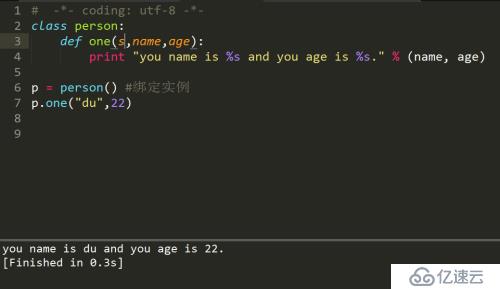一,self含义
# -*- coding: utf-8 -*-
class person:
def one(self,name,age):
print "you name is %s and you age is %s." % (name, age)
p = person() #绑定实例
p.one("du",22)执行结果:
you name is du and you age is 22.其实self可以不必写成self,但是必须要有一个参数如下图

详细了解可以参考博客:http://www.cnblogs.com/jessonluo/p/4717140.html
二,__init__初始化。
# -*- coding: utf-8 -*-
class person:
def __init__(self,sex):
self.sex = sex
def one(self,name,age):
print "you name is %s and you age is %s and sex is %s" % (name, age, self.sex)
p = person("boy") #绑定实例
p.one("du",22)执行结果:
you name is du and you age is 22 and sex is boy其实就相当于变量sex在类里。比函数大一级别。如下面的程序,和上面的执行结果是一样的。
# -*- coding: utf-8 -*-
class person:
sex = "boy"
def __init__(self,sex):
#self.sex = sex
pass
def one(self,name,age):
print "you name is %s and you age is %s and sex is %s" % (name, age, self.sex)
p = person("boy") #绑定实例
p.one("du",22)
亿速云「云服务器」,即开即用、新一代英特尔至强铂金CPU、三副本存储NVMe SSD云盘,价格低至29元/月。点击查看>>
免责声明:本站发布的内容(图片、视频和文字)以原创、转载和分享为主,文章观点不代表本网站立场,如果涉及侵权请联系站长邮箱:is@yisu.com进行举报,并提供相关证据,一经查实,将立刻删除涉嫌侵权内容。